Thai Mythical Creatures: Where to Find Them?
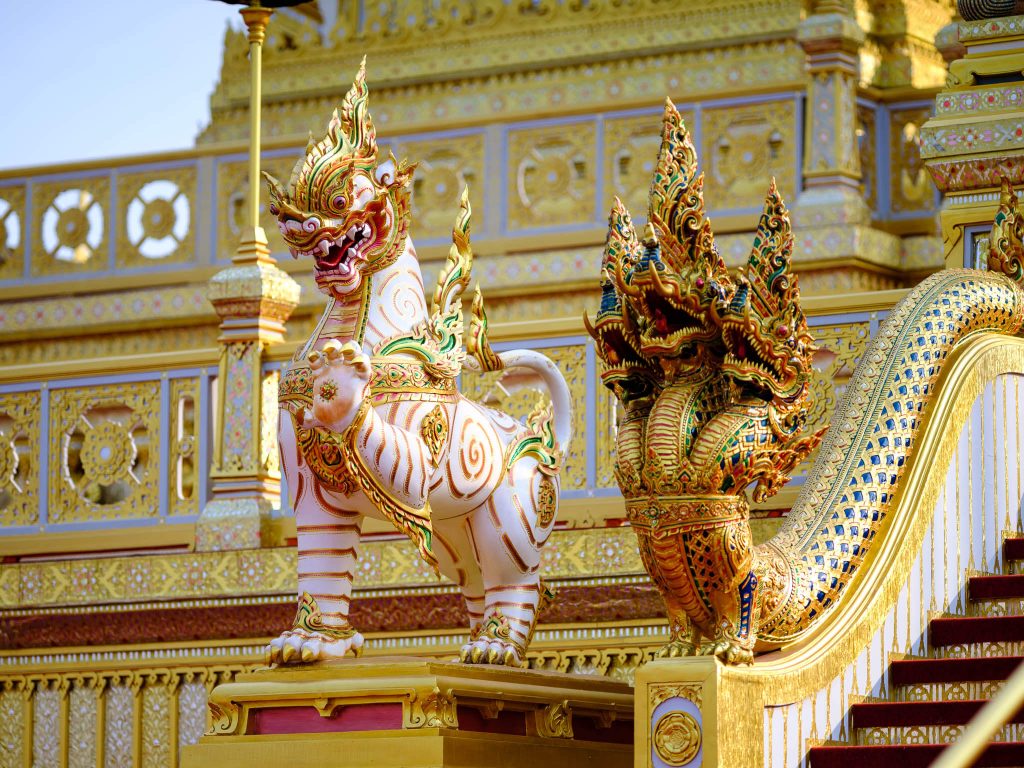
[photo cr. Pantip]
Mythical creatures like the sphinx, kraken, dragon, and Cerberus are known the world over. For Thais, we have a plethora of beings that are equally intriguing from a noble elephant with six tusks, to a giant bird that can part the sea with a single flap of its wings, to extraordinary trees that bear fruits in the form of beautiful women.
These mythical beings dwell within the Himmapan Forest (Thai:ป่าหิมพานต์), a faraway magical land full of mysteries and wonders.
How many kinds of creatures are there? Where exactly is the Himmapan Forest? Why are these creatures culturally significant? We are here to explore the answers.
An Assortment of Beings
There is a multitude of mythical Himmapan creatures. From magical types to those with supernatural powers, and the most fascinating of all are ones that are a combination of different animals.
These creatures denote cultural ways that are indicative of a vast number of ancestral roots. From Buddhist legends, Brahmanism, folklores, and even influences from Chinese and western arts. This is testament of the Thai people’s innovative thinking and openness to embrace other cultures.
Example of Himmapan creatures can be summarized as follows.
The elephant clan:
- Karinta Paksa (Thai: กรินทปักษา) is black in color. He has red ears and a bird’s tail.
- Chattan Hudtee (Thai: ฉัททันต์หัตถี) has a white torso. His tail, feet, and back ridge are red. He has six tusks, the ability to fly, and moves swiftly on his feet.
- Hem Hudtee (Thai: เหมหัตถี) is golden in color and has super strength.
- Kunchon Waree (Thai: กุญชรวารี) has an elephant torso and the tail of a fish.
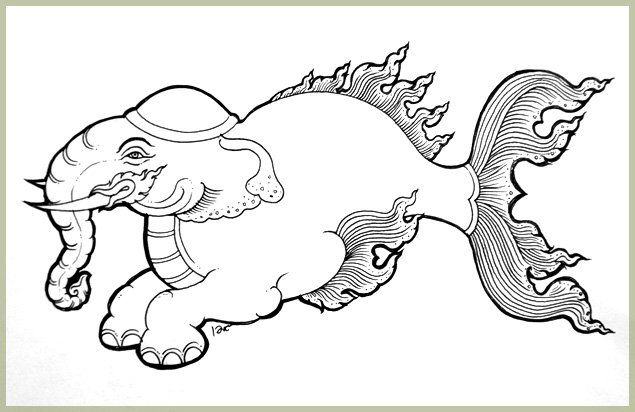 Kunchon Waree [photo cr. Pinterest:Panyapas Sripraphassorn]
Kunchon Waree [photo cr. Pinterest:Panyapas Sripraphassorn]
The lion clan:
- Kraisorn Rajasri (Thai: ไกรสรราชสีห์) is pure white in color with spirals across his torso. He has large eyes. His lips, tail tip, and claws are red.
- Kala Sriha (Thai: กาฬสีหะ) is jet black and has a cow-like torso. He consumes grass.
- Tinna Sriha (Thai: ติณสีหะ) has a cow-like body. He consumes grass.
- Buntu Rajasri (Thai: บัณฑุราชสีห์) is yellow with black stripes and a white underbelly. His body resembles a tiger. He is a carnivore.
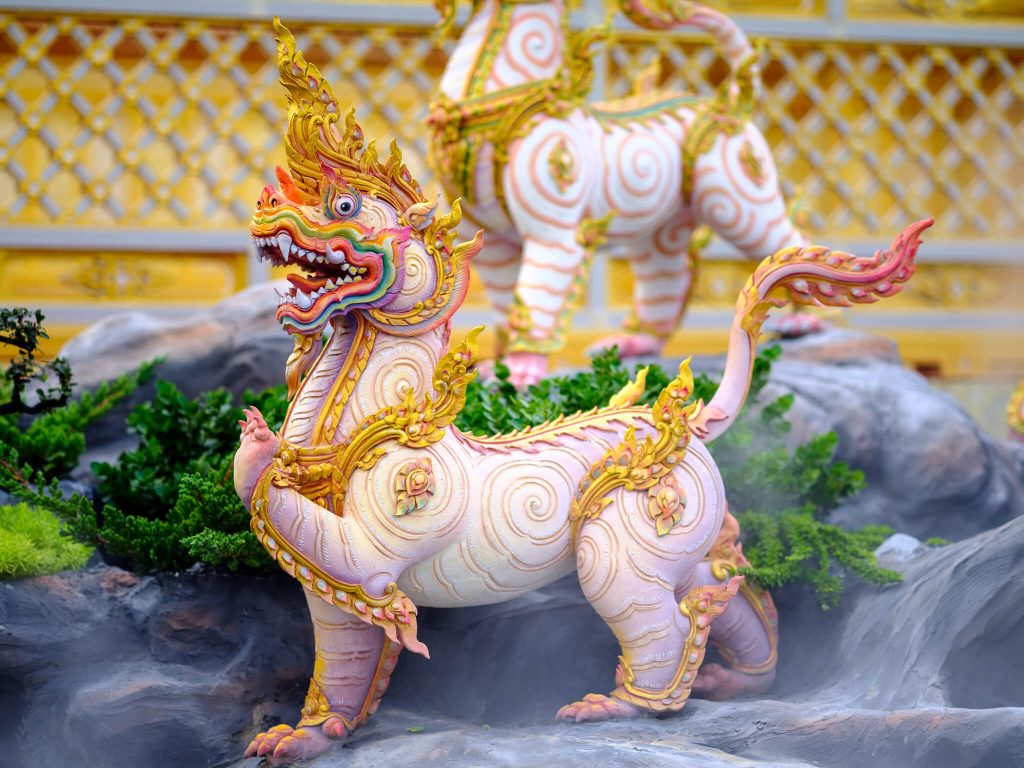
Kraisorn Rajasri [photo cr. Pantip]
The horse clan:
- Durong Kraisorn (Thai: ดุรงค์ไกรสร) is red in color. His head is that of a lion and he is regal. He is a carnivore.
- Hemara Ussadorn (Thai: เหมราอัศดร) has a horse torso and the head of a bird.
- Durong Paksin (Thai: ดุรงค์ปักษิณ) is a winged horse that is pure white in color. He has a bird-like tail. His neck, hooves, and tail are jet black.
- Mah Nin Mungkorn (Thai: ม้านิลมังกร) is half-horse and half-dragon, a form influenced by the Chinese qilin (Thai: กิเลน).
 Mah Nin Mungkorn [photo cr.สัตว์ในวรรณคดีไทย]
Mah Nin Mungkorn [photo cr.สัตว์ในวรรณคดีไทย]
The bovine clan:
- Ko U-Suparaj (Thai: โคอุสุภราช) is a noble cow. He is black with seven white spots on his body, front legs, chest, tail, and hump.
- Ko Prueksa Kawain (Thai:โคพฤกษกวาริน) has the torso of a cow and the tail of a fish. He is white and has a brown ridge.
- Ko A-Supa Paksin (Thai:โคอศุภปักษิณ) is blue with white legs. He has wings and a bird-like blue tail.
- Paksa Kawi (Thai: ปักษาคาวี) is cream colored with a bird-like tail and has horns.
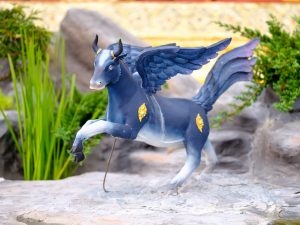
Ko A-Supa Paksin [photo cr. Pantip]
The bird clan:
- Garuda, or Krut (Thai: ครุฑ), is a half-man and half-bird. He is powerful and is the vehicle Lord Vishnu, one of the three supreme deities of Hinduism.
- Nok Hussadiling (Thai: นกหัสดีลิงค์) is a large bird that has a trunk and tusks like an elephant.
- Kinnaree/Kinnanorn (Thai: กินรี /กินนร) is half-man and half-bird (the females are called Kinnaree and the males Kinnanorn). Their abode is on the Himmapan mountaintop known as Chanta Bunpot (Thai: จันทบรรพต).
- Nok Tantima (Thai: นกทัณฑิมา) has a torso of a Garuda and the head of a bird. He carries a staff at all times. Tanta (Thai: ทัณฑ) means staff.
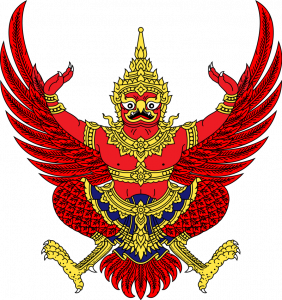
Phaya Krut (King of the Krut) depicted on the National Emblem of Thailand [photo cr. Wikipedia]
The marine clan:
- Hae Ra (Thai: เหรา) has the torso of naga. He has legs, horns, and a kanok plaew (Thai:กนกเปลว, flame-like patterns) comb. He has an elongated face, pointed nose, and big eyes. His lips are red. He has fangs, and two rows of sharp teeth.
- Naga, or Phaya Nak (Thai: พญานาค) is a serpent with scales and a golden comb. It is a very powerful being with the ability to shapeshift. There are four naga families.
- Virupak (Thai: วิรูปักษ์) the golden naga.
- A-Ra Pata (Thai: เอราปถ) the green naga
- Chubpaya Putta (Thai: ฉัพพยาปุตตะ) the rainbow naga
- Kanha Kotama (Thai: กัณหาโคตมะ) the black naga
- Mermaid, or nguek (Thai: เงือก) has an upper torso of a human and lower torso of a fish. This depiction is most likely influenced by western mythologies, as traditional Thai descriptions of ngueks are more serpentine in features.
- Nak Paksa (Thai: นาคปักษา) is a bird with a head that resembles a naga. Each layer of his feathers alternate in color.
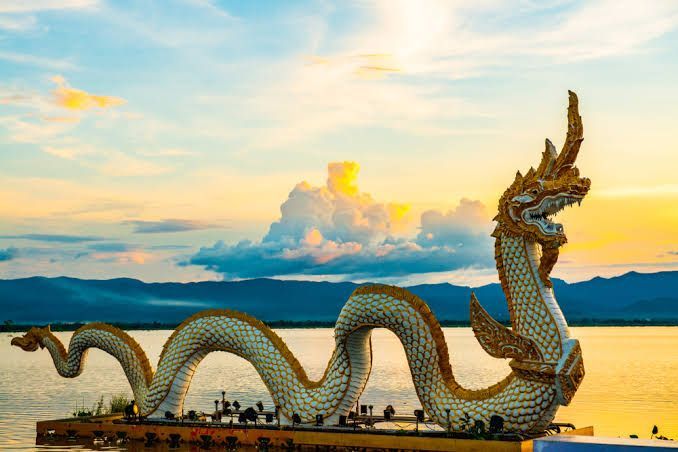
Phaya Nak [photo cr. blockdit: Masterpiece STONE]
Others
- Makalipon tree (Thai:มักกะลีผล ) bears young women as fruits. They are mentioned in the Vessantara Jataka (Thai: เวสสันดรชาดก).
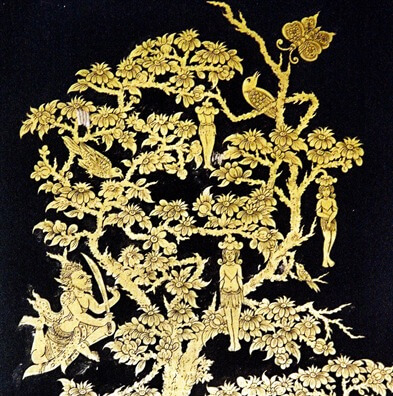
Makalipon [photo cr. SPB]
From Geography to Legend
The story of the Himmapan Forest appears in Thai classical literatures, the vast forest is said to be the home of mythical creatures of all sizes. The Himmapan Mountain is a mountain range that is made up of as many as 84,000 smaller mountains. Some examples of smaller mountains mentioned in the classical literature are Khao Sutatsana (Thai:เขาสุทัศนะ), Khao Jittrakood (Thai:เขาจิตรกูฎ), Khao Kalakood (Thai: กาฬกูฎ), Khao Kantamat (Thai: คันธมาทน์ ), and Khao Kailasa (Thai: ไกรลาส) where Shiva resides. Thailand became acquainted with these legends through the spread of Brahmanism and Buddhism. This can be seen through references of the forest in religious tales, such as the Vessantara Jataka – a tale of one of Lord Buddha’s past lives.
The Himmapan Forest, in actual fact, is based on the Himalaya mountains. In the old days, the people of India viewed the Himalaya as the center of the universe. This gave life to a belief in Buddhist and Brahman legends of Mount Sumeru (Thai: เขาพระสุเมรุ), a vast mountain system that is also considered the center of the universe and an axis of the heavens and earth. The Himmapan Forest and even Khao Kailasa, Shiva’s abode, also exist in real life.

The Himalayas [photo cr. Britanica]
When Buddhism and Brahmanism first came to Southeast Asia, the Himalaya was considered faraway and so arduous to reach that their tales and legends were full of marvel for the Thai people. Believing that the great distance makes the journey formidable for mere mortals that only angels, sorcerers, and saintly beings can reach by flying through the air, Thais further envisioned this unseen forest to house an assortment of exotic plants and creatures; hence the conception of extraordinary creatures to further strengthen the belief.
Because of the unlikelihood of reaching the Himmapan Forest, in the past, those claiming to have set foot there were simply disregarded. Even during the reign of King Rama V (1868-1910) when the country had prospered significantly, people still believed that it was untrue. An excerpt from a narrative by Prince Damrong Rajanubhab (Thai: สมเด็จพระเจ้าบรมวงศ์เธอ กรมพระยาดำรงราชานุภาพ) to Prince Narisara Nuwattiwong (Thai: สมเด็จพระเจ้าบรมวงศ์เธอ เจ้าฟ้ากรมพระยานริศรานุวัดติวงศ์) reads:
“Upon my return from Europe via India, Phraya Siritham Borirak (Tai) (Thai: พระยาศิริธรรมบริรักษ์ (ทัย)) who was still my royal page at the time, came to receive me in Calcutta. I showed him the sights all the way to Darjeeling atop the Himalaya and made known to him that we were in the Himmapan Forest. As we returned to Bangkok, Phraya Siritham paid a visit to Phra Tham Thanajarn (Joon) (Thai: พระธรรมนาจารย์ (จุ่น)) of Wat Srakesa (Thai: วัดสระเกศ), and was asked by the venerable monk where he had been. Phraya Siritham replied that he had visited the Himmapan Forest but was admonished for picking up a deceptive trait from his short time abroad. Phraya Siritham insisted of his visit to the Himmapan Forest and it further angered the monk. “You must think I do not know that only angels and powerful sorcerers who can fly through the air can reach the Himmapan Forest. You’re just a mortal that walks the earth. So how can you get there? I do not believe you.”
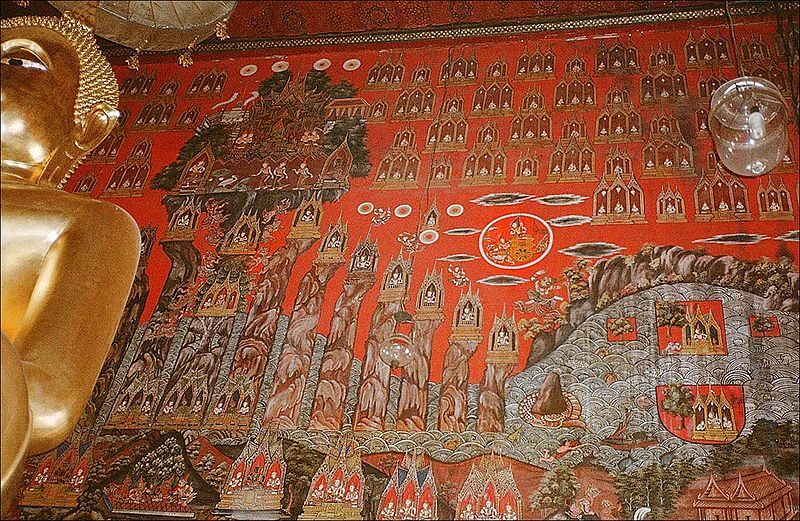
Mural depiction of Thai cosmology [photo cr. Wikipedia]
Creatures in Architecture
Himmapan creatures are often depicted in numerous Thai architectures particularly for religious structures and those used for the royal institution. It is a mark of religious belief and of sovereignty. Southeast Asia had adopted a blend of Brahman and Buddhist beliefs together with local faiths, thus creating a unqiue culture. Thai architectures illustrate the Buddhist belief in the three planes of existence, or Traibhumi (Thai:ไตรภูมิ). At the heart of the universe is Mount Sumeru. It is surrounded by the four oceans and the satellite mountainsAbove Mount Sumeru are the different heavenly realms. These are symbolized in the construction of Thai temples where the main structures, such as chedi (Thai:เจดีย์), u-bohsot (Thai:อุโบสถ), and viharn (Thai: วิหาร) represent Mount Sumeru while the surrounding structures signify the four continents and satellite mountains. Furthermore, images of mythical creatures are often depicted within the vicinity of the main site in order to mimic the scenery of the Himapan Forest. This gave worshipers a sense of undertaking a pilgrimage to the magical land.
In terms of governance, the monarchs of Southeast Asian states identify themselves with Hindu divinities. This led to creation of court culture and protocols that are centered around religious beliefs. As for Thailand, Himmapan animals symbolizes the divinity of the monarchs, as clearly demonstrated in the construction of the royal crematoriums or Phra Meru Mas (Thai: พระเมรุมาศ) for funerals of kings and members of the royal family.
The royal crematorium is a representation of Mount Sumeru. The inclusion of Himmapan animal effigies in royal funerals has been a practice since the Ayutthaya period (1351-1767) and modified through time. Historical records show that angels, Vidyadhara (Thai: วิทยาธร), Gandharva (Thai: คนธรรพ์ ), Garuda, kinnorn, kotchasri (Thai: คชสีห์), rajasri (Thai: ราชสีห์), hem (Thai: เหม), hongse (Thai: หงส์), norasingh (Thai: นรสิงห์), mungkorn (Thai: มังกร), hae ra, naga, tukkator (Thai: ทักกะทอ), elephants, horses, mountains goats, and several other animal effigies were laid around the royal funeral pyre at the royal funeral of King Borommakot (Thai: พระเจ้าอยู่หัวบรมโกศ). For the funeral procession, 10 types of animal figures were included, each type consisted of one pair, which were; elephants, horses, kotchasri, rajasri, lions, mungkorn, tukkator, norasingh, hem, and hongse. The figures stood at four cubits in height with a mondop (Thai: มณฑป) on their backs to hold incense, oil, borneo camphor, and other fragrances used in the royal rituals.
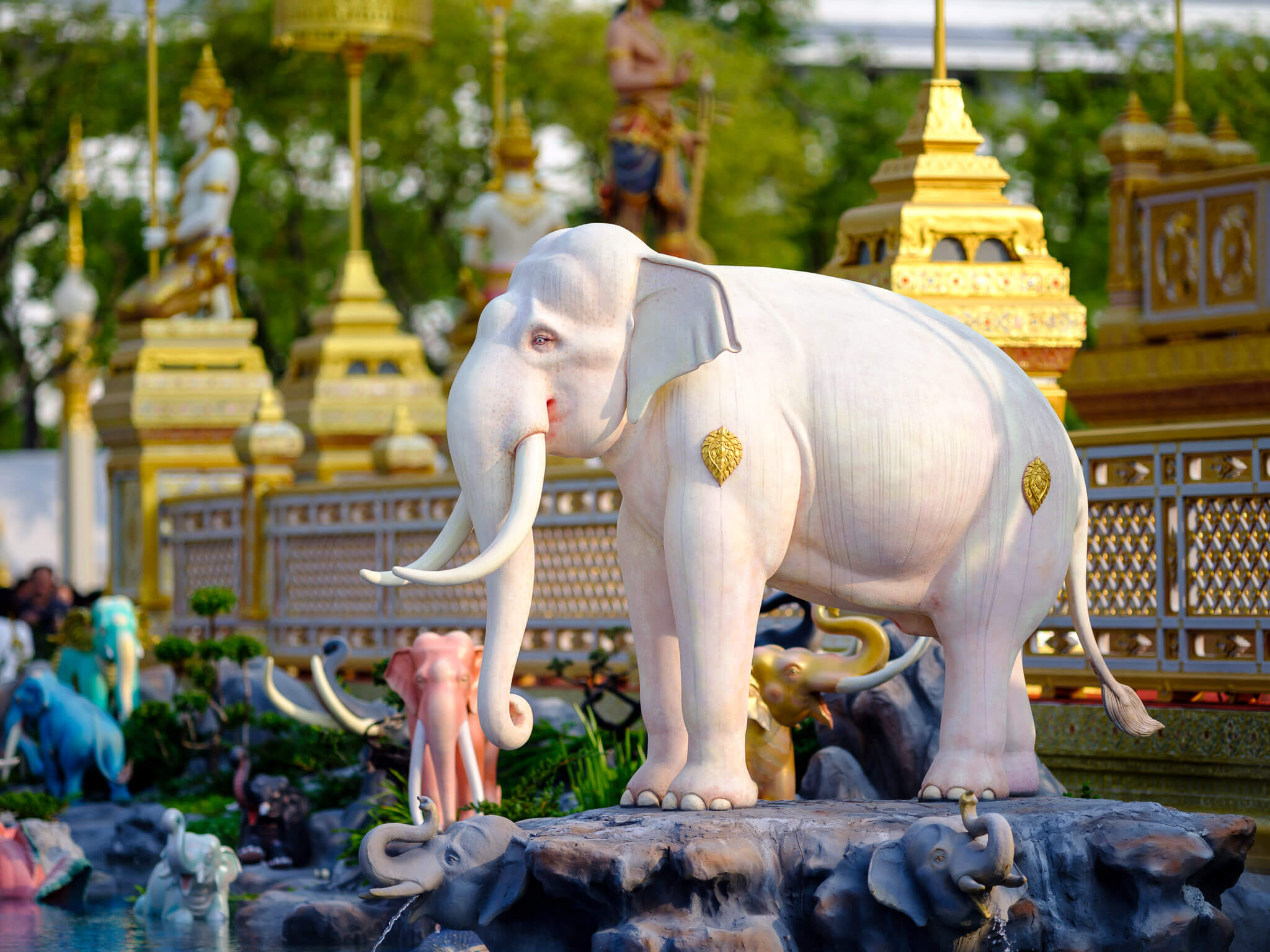
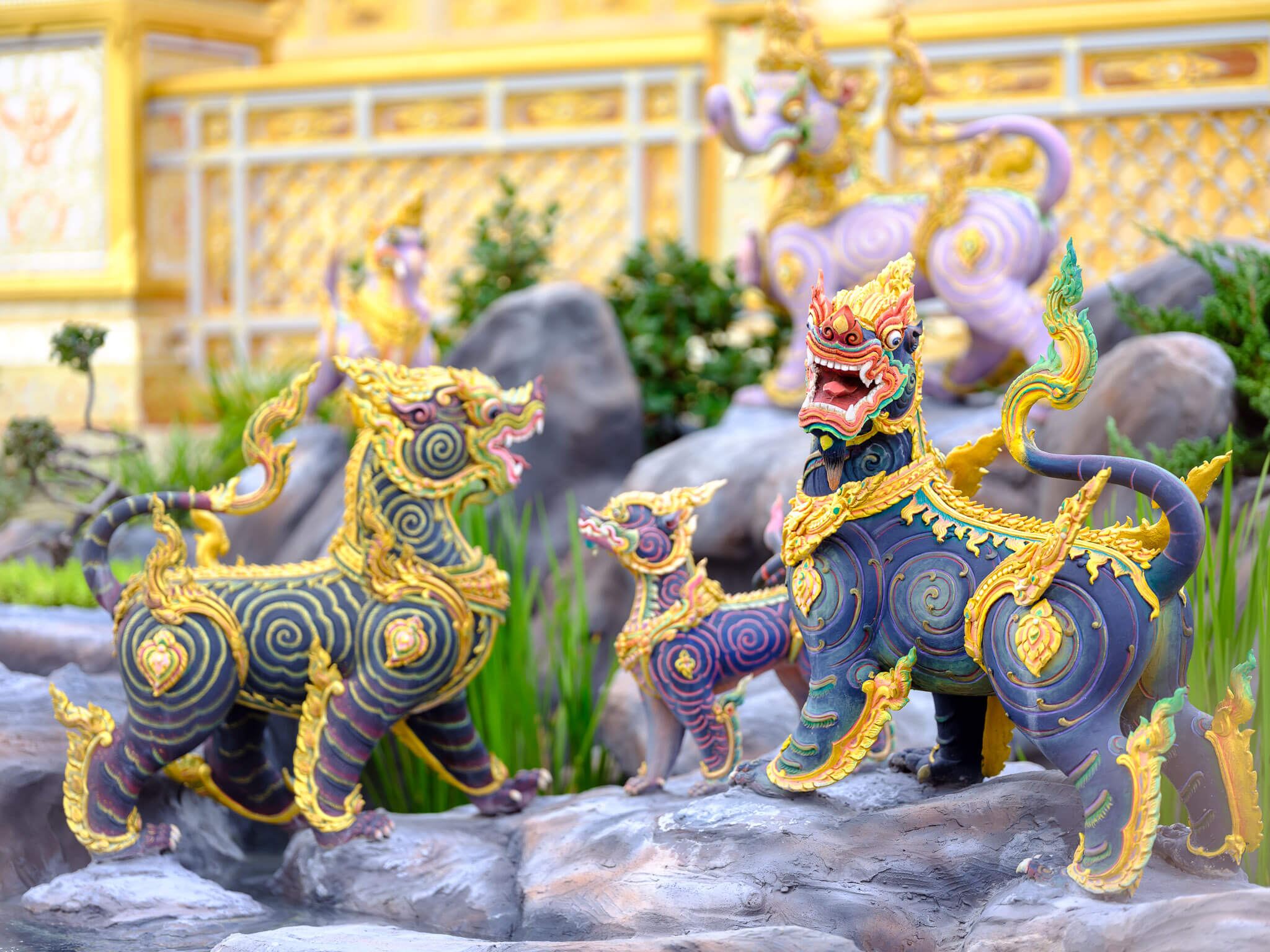
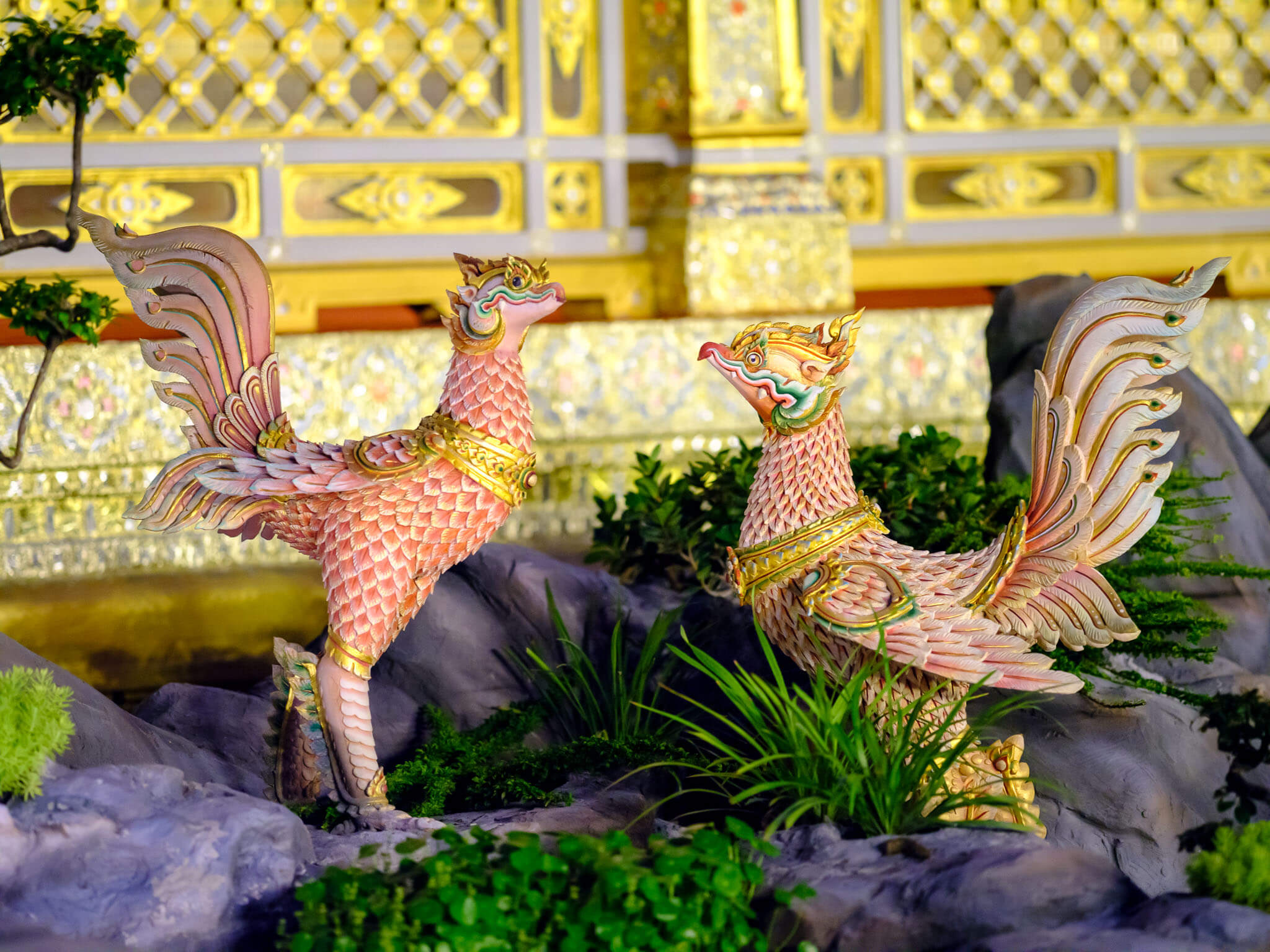
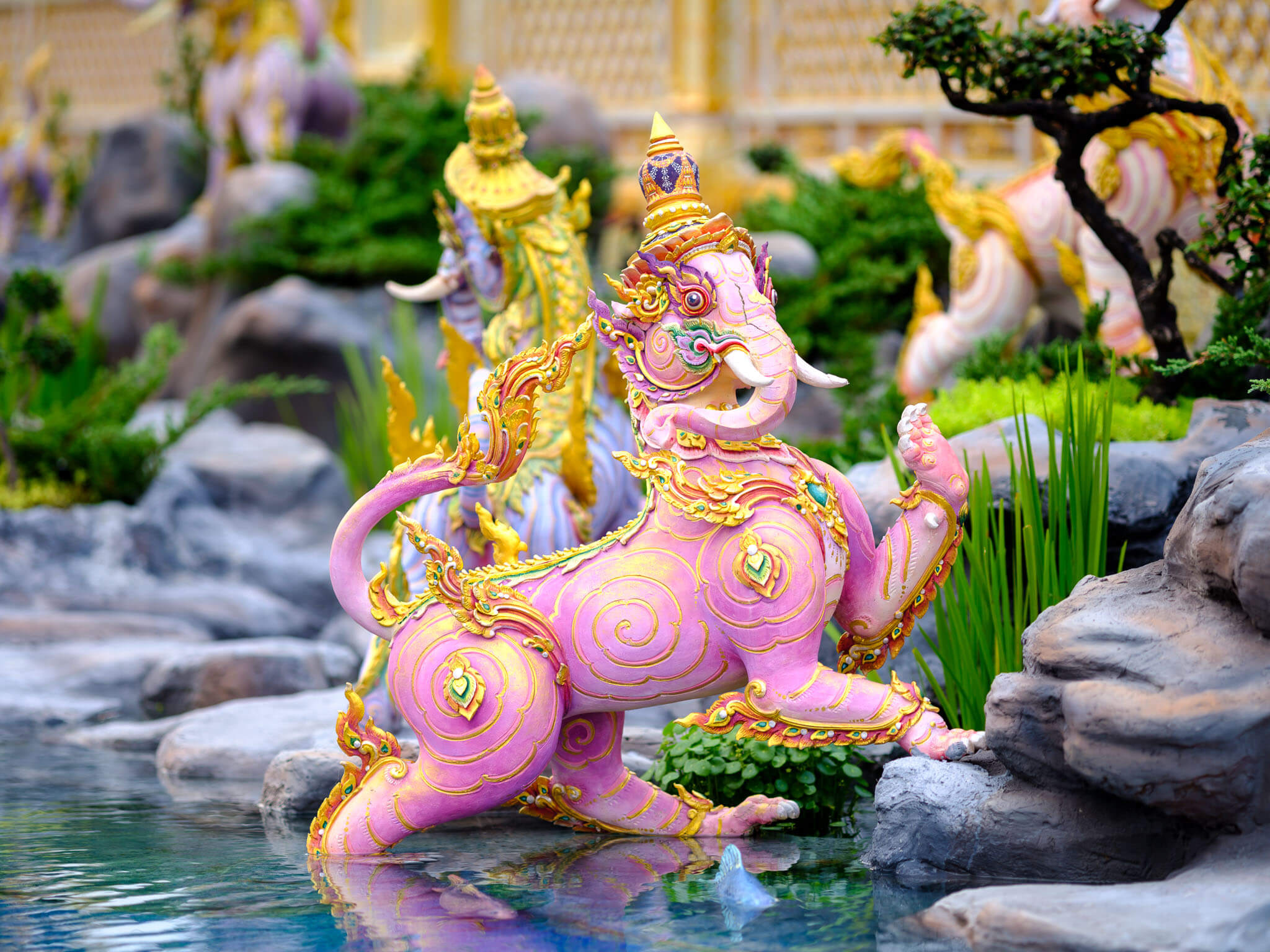
Creatures from the royal crematorium of H.M. King Bhumibol Adulyadej [photo cr. Pantip]
The inclusion of animal effigies in royal funeral processions was no longer practiced by the time of the Rattanakosin era (1782-1932), however, animal sculptures continue to adorn royal crematoriums. The latest example of this was the royal funeral of King Bhumibol Adulyadej (Thai: พระบรมชนกาธิเบศรมหาภูมิพลอดุลยเดชมหาราชบรมนาถบพิตร) where as many as 120 sculptures of Himmapan animals were crafted. These include 10 parades of elephants, four prides of lions, four teams of horses, eight herds of cattle, and a mixture of other animals. The crafting of these sculptures not only reflect cultural beliefs, but it gives craftsmen the opportunity to showcase their finesse and share their experience and learn from senior artisans. The constructions of royal crematoriums are thus opportune events for lengthening the legacy of Thai art and craftsmanship.
References
- Sombat Plainoy “Himmapan Creatures.” Watthanatham Journal: Department of Cultural
- Promotion, yr. 57, no. 1, January – March. 2019, pp. 35 – 41. Retrieved April 1, 2021. Link: http://magazine.culture.go.th/2018/1/mobile/index.html#p=36
- Database of the Royal Crematorium and Accessories


